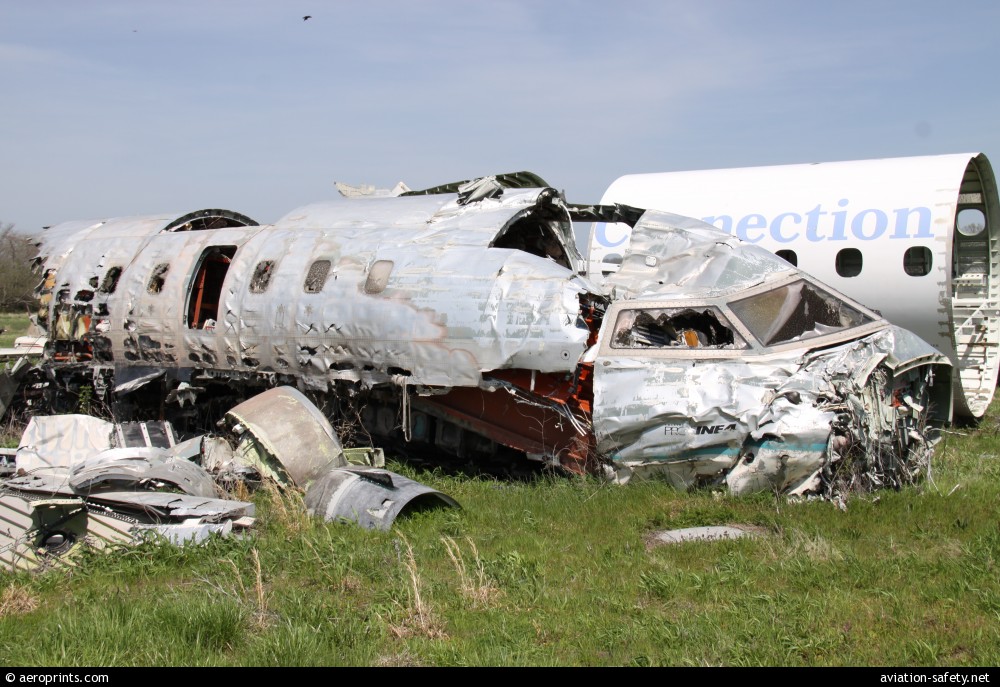
| Date: | Tuesday 10 October 2000 |
| Time: | 14:52 |
| Type: |  Bombardier CL-600-2B16 Challenger 604 |
| Owner/operator: | Bombardier Aerospace |
| Registration: | C-FTBZ |
| MSN: | 5991 |
| Year of manufacture: | 1994 |
| Total airframe hrs: | 1226 hours |
| Engine model: | General Electric CF34-3B |
| Fatalities: | Fatalities: 2 / Occupants: 3 |
| Aircraft damage: | Destroyed, written off |
| Category: | Accident |
| Location: | Wichita-Mid-Continent Airport, KS (ICT) -
 United States of America United States of America
|
| Phase: | Take off |
| Nature: | Test |
| Departure airport: | Wichita-Mid-Continent Airport, KS (ICT/KICT) |
| Wichita-Mid-Continent Airport, KS (ICT/KICT) | |
| Investigating agency: | NTSB |
| Confidence Rating: |
Canadair CL-604 Challenger C-FTBZ was being used to conduct flight tests in order to obtain CAA (U.K.) certification. Following the first flight tests in 1999, the CAA provided a list of unacceptable items that Bombardier needed to correct before the Challenger 604 could obtain CAA certification, which included modification of the PFS units. Following ground tests at Wichita, flight testing of the modified pitch feel simulator (PFS) units was to take place. The flight crew was to initiate a standard takeoff and climb and conduct flight testing of modified PFS units above 8,000 feet agl. The test required that the airplane be configured with an aft center of gravity. Prior to takeoff, a preflight briefing was held and a risk analysis from Bombardiers manager of flight test operations and safety was obtained. The flights risk level was assessed low. At 14:48:45, the tower issued a takeoff clearance and instructed the flight crew to fly a heading of 230°. The Challenger then commenced takeoff from runway 19R. The airplane rotated and just after reaching V2 (takeoff safety speed) the stick shaker activated during which time the pilot stated "whew," and the flight test engineer stated "what are you doing?". The CVR then recorded the mechanical voice warning "bank angle" and a sound similar to stall aural warning for 1.1 seconds at 14:49:53. The "Bank angle" warning sounded another four times. At 14:49:58, and for the next 2 seconds, the stick shaker activated again, and the pilot stated, "hang on." A sound similar to stick shaker" was recorded again; the flight test engineer repeated "what are you doing?" followed by a sound similar to stall aural warning, and "bank angle" again. The airplanes right wing rolled and impacted the ground first and the airplane exploded on impact. The airplane crashed through an airport perimeter fence and came to rest adjacent to a two-lane road.
PROBABLE CAUSE: "The National Transportation Safety Board determines that the probable cause of this accident was the pilots excessive takeoff rotation, during an aft center of gravity (c.g.) takeoff, a rearward migration of fuel during acceleration and takeoff and consequent shift in the airplanes aft c.g. to aft of the aft c.g. limit, which caused the airplane to stall at an altitude too low for recovery. Contributing to the accident were Bombardiers inadequate flight planning procedures for the Challenger flight test program and the lack of direct, on-site operational oversight by Transport Canada and the Federal Aviation Administration."
Accident investigation:
 |
|
Sources:
NTSB
Location
Images:

photo (c) ASN archive; Wichita-Mid-Continent Airport, KS (ICT); 10 October 2000

photo (c) ASN archive; Wichita-Mid-Continent Airport, KS (ICT); 10 October 2000

photo (c) ASN archive; Wichita-Mid-Continent Airport, KS (ICT); 10 October 2000

photo (c) ASN archive; Wichita-Mid-Continent Airport, KS (ICT); 10 October 2000

photo (c) aeroprints.com; Rantoul, KS; 30 April 2013; (CC:by-sa)

photo (c) aeroprints.com; Rantoul, KS; 30 April 2013; (CC:by-sa)
Revision history:
| Date/time | Contributor | Updates |
|---|
The Aviation Safety Network is an exclusive service provided by:


 ©2024 Flight Safety Foundation
©2024 Flight Safety Foundation